The monthly Consumer Price Index dropped -0.3% for November. That's some serious deflation but not to worry, it's all about falling oil prices. Gasoline prices declined the steepest since December 2008. Inflation with gas and food removed increased a very tame 0.1%. CPI measures inflation, or price increases.

CPI has only increased 1.3% from a year ago due to the collapse in gasoline and is shown in the below graph. Great news for those who drive a lot.
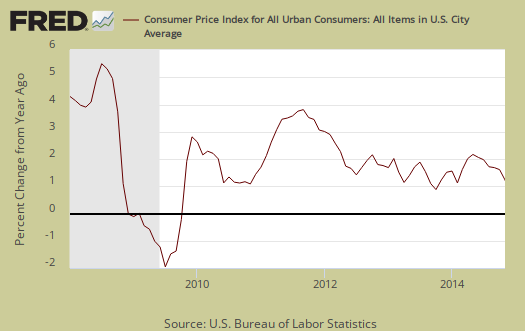
Core inflation, or CPI with all food and energy items removed from the index, increased 0.1% and has increased 1.7% for the last year. Core CPI is one of the Federal Reserve inflation watch numbers and 2.0% per year is their target rate. Graphed below is the core inflation change from a year ago.
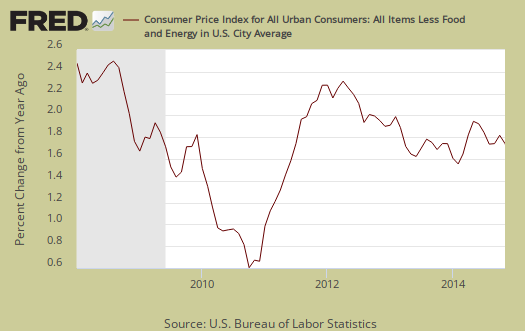
Core CPI's monthly percentage change is graphed below. Deflation is a grave concern for the Federal Reserve and they appear to be keeping interest rates low regardless.
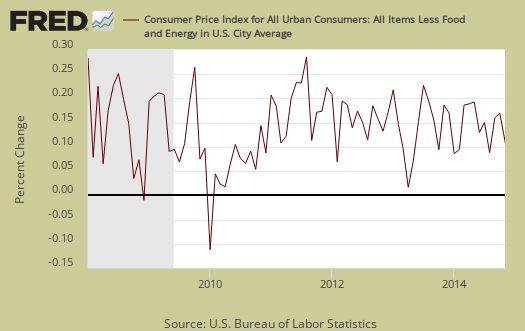
Onto the big story in this month's report. Energy overall declined -3.8% for the month and energy costs are now down -4.8% from a year ago. This decline should be even more dramatic next month since oil & gas prices are still dropping like a stone. The BLS separates out all energy costs and puts them together into one index. This index includes gasoline which dropped -6.6% for the month and has declined -10.5% for the year. Fuel oil dropped -3.5% for the month, down -10.1% for the year. Natural gas is now up 3.2% from a year ago with a monthly decline of -1.7%. Electricity increased 0.1% for the month and is now up 2.8% for the year. Graphed below is the overall CPI energy index.

Graphed below is the CPI gasoline index only, which shows gas prices wild ride. Gasoline is best news.
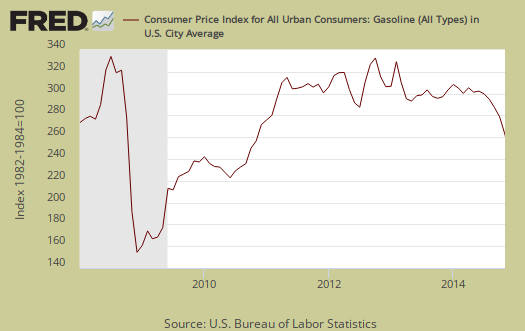
Core inflation's components include shelter, transportation, medical care and anything not food or energy. The shelter index is comprised of rent, the equivalent cost of owning a home, hotels and motels. Shelter increased 0.3% and is up 3.0% for the year. The cost of housing is clearly jumping up and considering most wages cannot afford a one bedroom apartment in many areas of the country, this is disconcerting. Rent increased 0.3% for the month, 3.5% for the year. This is just awful since lower income people rent and this is their largest expense. Additionally this is the national average,, rents in some areas of the country are just soaring. Home prices are increasing as reflected in the cost for home owners increased 2.7% for the past year as well. Graphed below is rent, where cost increases hits the people who can least afford it.
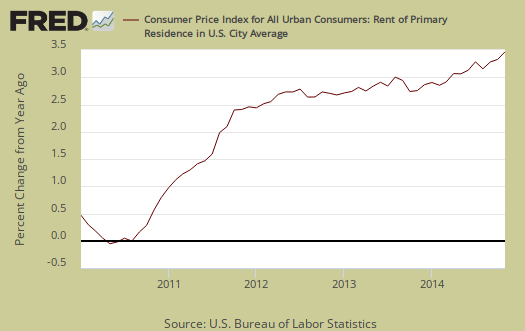
A core inflation cost which almost never drops is medical care. Medical care went back on the rise and increased 0.4% in November and this is the biggest jump since August 2013. The medical care index has increased 2.5% over the last 12 months. Graphed below is the overall medical care index change from a year ago.
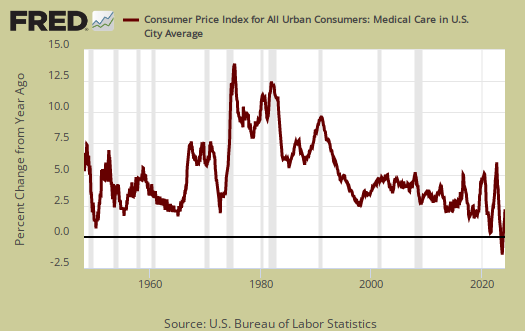
Below is a graph of the medical commodities index, which in large part consists of prescription drug prices, up a whopping 0.6% for month and 3.1% for the past year. Notice the beyond belief never ending increases since 1975 in the below graph. Meanwhile Americans are force feed expensive pharmacuetical marketing campaigns to the point that act, by itself, is probably making people sick.
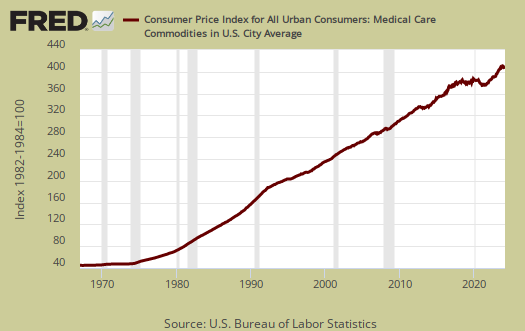
Food and beverages overall increased 0.2% for the month and have increased 3.2% from a year ago. The food at home index, i.e. groceries, increased 0.2% for the month and 3.4% for the year. Eating out, or food away from home increased 0.1% from last month and is up 3.4% from a year ago. Graphed below is the overall food index.
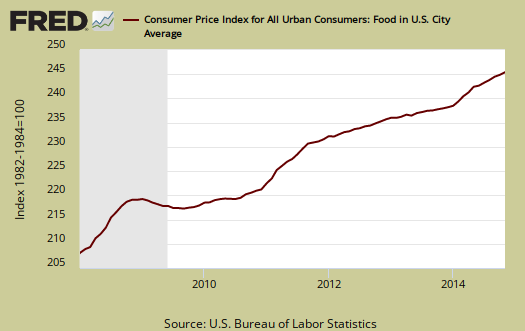
Graphed below is the food at home index, which is deceptive due to the BLS assuming one will substitute items when a large increase occurs.
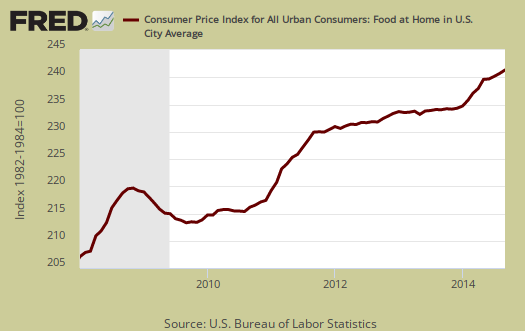
Individual food items so one gets a better feel for what is going on. Beef & veal are up 18.1% for the year with beef roasts up 2.0% for the month and 19.5% for the year. Even not canned hammed have increased 15.2% over the year. nbsp;It is not your imagination, groceries have increased dramatically.
The BLS released real hourly earnings for November. The average hourly real wage rose 0.6% and is now $$10.40 and has increased 0.8% for the year. This means wages are not keeping up with inflation, what a surprise. Weekly real earnings increased 0.9% because not only wages increased 0.6% but because people were working 0.3% more hours per week.
CPI details
The DOL/BLS does take yearly surveys on where the money goes in the monthly budget, but as one can see, food and energy are significant amounts of the monthly finances. Run away costs in these two areas can break the bank, so can food. Additionally CPI uses substitution, so if flour goes through the roof, somehow we're all just fine with oats and prices didn't really overall increase much. Here is the BLS CPI site, where one can find much more details, information on calculation methods and error margins.
Other CPI report overviews, unrevised, although most graphs are updated, are here. If you're wondering why the graphs display different figures from the text, the graphs calculate percentages from the index and do not round. The actual data from the BLS report does round to one decimal place. In other words, 0.05% is rounded to 0.1%.

prices for goods, especially durables
what's hidden in the core CPI is that prices prices for goods have been falling while prices for services have generally tended to rise, and since services are more heavily weighted, the lower prices for goods is rarely noticed...for instance, prices for household furnishings and supplies, the commodity component of housing, fell by 0.5%, with a 4.4% drop in prices for laundry appliances, a 1.9% decrease in prices for linens, 1.8% lower prices for decor items and 1.2% lower cookware and tableware more than offsetting a 3.4% increase in the price of window coverings...the price index for apparel fell 1.1% in November as a 3.7% drop in prices for women's outerwear, a 3.4% drop in prices for girls apparel, a 2.4% drop in prices for women's suits, 1.7% lower priced boys' and girls' footwear, and 1.2% lower prices for men's suits, coats, and outerwear, more than offset a 1.7% increase in the prices of men's pants and shorts. ...meanwhile, prices for transportation commodities less fuel prices fell 0.4%, as prices for new cars and trucks fell 0.1%, prices for used cars & trucks fell 1.2%, tire prices fell 0.4% and prices for oil & other automotive fluids fell by 0.5%; recreation commodities fell 0.6% as television prices fell 3.2%, prices for other video equipment fell 2.7%, prices for audio equipment fell 1.2%, and prices for both toys and photography equipment fell 0.9%, education and communication commodities fell 0.9% on a 2.9% drop in prices for telephones and other consumer information hardware and 1.5% lower prices for personal computers and similar gear...in November, 3 line items among the CPI core components showed a annual price drops of greater than 10%: televisions, which have fallen in price by 16.2%, telephone hardware, which is now priced 10.6% less, and laundry appliances, which are now 10.2% cheaper than they were a year ago...
rjs
still shelter trumps all
Rent is clearly going through the roof...
weight of housing
true, but it's weighted heavily in the CPI compared to how the BEA weighs it in national accounts...shelter is 32% of the CPI, and the housing aggregate is 41.668% of the CPI, while housing and utilities was just 18% of PCE in the 3rd quarter...
rjs